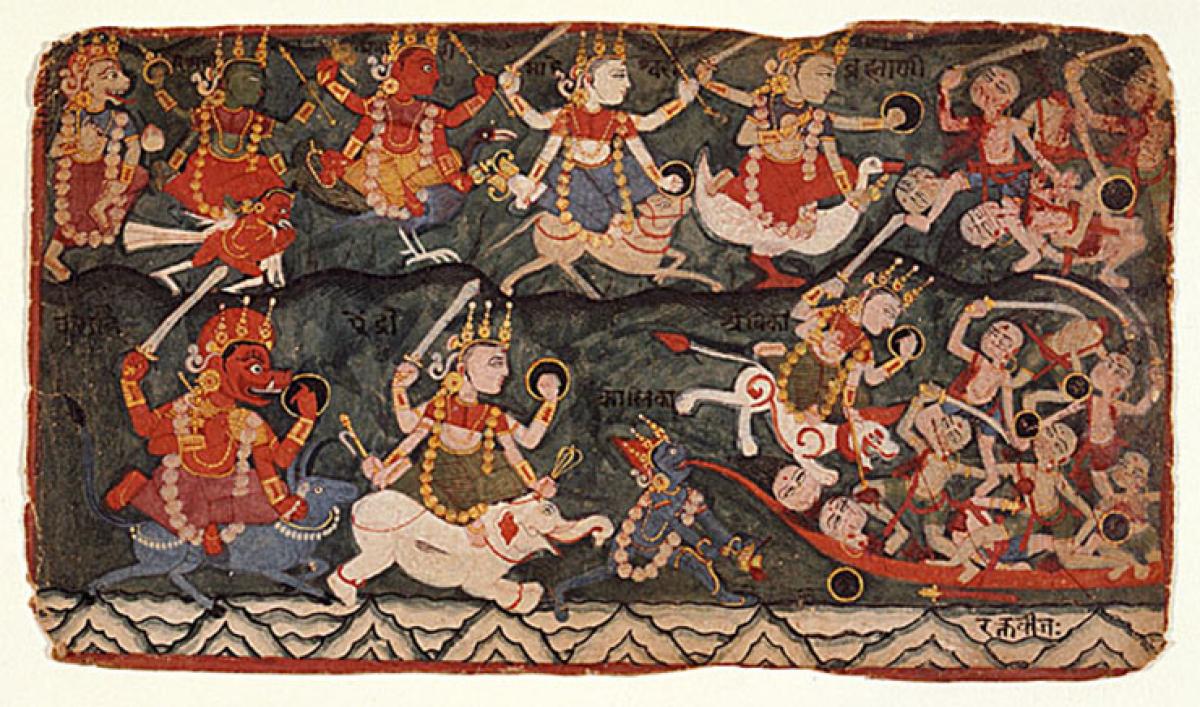Live
- Congress intended to exploit farmers for political gain in Haryana: BJP
- Exalogic case: SFIO records statement of Kerala CM's daughter Veena
- APSDMA issues alert amid rain forecast, sets up toll-free numbers
- Congress' relevance as national entity declining: JD(U) leader on BKU chief's remarks
- Mongolia, Turkmenistan sign cooperation documents
- Man stabbed to death over car parking dispute in Kashmir
- ‘Very technically correct’ Root enjoying best years of his career, says Boycott
- Grand Dasara Celebrations at Nagar Kurnool Tank Bund
- Canada: Mysterious white blobs wash up on beaches
- Detained Ukrainian journalist dies in prison
Just In

The word Upanishad is derived from upa (nearby), and nishad (to sit-down), that is, “sitting down near”. Groups of pupil sit near the Guru to learn from him in the Guru-shishya parampara or tradition. The Upanishads mark the culmination of Indian thought and are the final parts of the Vedas. As the Upanishads contain abstract and difficult discussions of ultimate philosophical problems, they were taught to the pupils at the end.
The word Upanishad is derived from upa (nearby), and nishad (to sit-down), that is, “sitting down near”. Groups of pupil sit near the Guru to learn from him in the Guru-shishya parampara or tradition. The Upanishads mark the culmination of Indian thought and are the final parts of the Vedas. As the Upanishads contain abstract and difficult discussions of ultimate philosophical problems, they were taught to the pupils at the end.
That is why they are called the end of Vedas. Vedas start with the worship of the manifest, as that is obvious and then slowly transform to the knowledge of the unmanifest There are more than 200 known Upanishads, one of which, the Muktika, gives a list of 108 Upanishads – this number corresponds to the holy number of beads on a mala or Hindu rosary.
.jpg)
The Upanishads form an important part of our literary legacy. They deal with questions like the origin of the universe, life and death, the material and spiritual world, nature of knowledge and many other questions. The earliest Upanishads are the Brihadaranyaka which belongs to the Sukla Yajur Veda and Chand yogya which belongs to the Sama Veda. Some of the other important Upanishads are the Aitareya, Kena, Katha Upanishad.
Try and find out some other important Upanishads on your own. Read them and you will find a whole new world of Indian philosophy opening in front of you. There are more books selling on the Upanishads. Start with the small stories. Get interested in them and than go to the whole book of any Upanishad.
Ramayana and Mahabharata
Our two great epics are the Ramayana and the Mahabharata. The Ramayana of Valmiki is the original Ramayana. It is called Adikavya and Maharishi Valmiki is known as Adi Kavi. The Ramayana presents a picture of an ideal society. The other epic, the Mahabharata, was written by Ved Vyas. Originally, it was written in Sanskrit and contained 8800 verses and was called “Jaya” or the collection dealing with victory.
These were raised to 24,000 and came to be known as Bharata, named after one of the earliest Vedic tribes. The final compilation brought the verses to 100,000, which came to be known as the Mahabharata or the Satasahasri Samhita. It contains narrative, descriptive and didactic material, relating to conflict between the Kauravas and the Pandavas.
The Mahabharata and the Ramayana have several renderings in different Indian languages. The Mahabharata contains the famous Bhagavad Gita which contains the essence of divine wisdom and is truly a universal gospel. Though it is a very ancient scripture, its fundamental teachings are in use even today In the Bhagvad Gita, Krishna explains to Arjuna his duties as a warrior and prince and elaborates on different Yogic and Vedantic philosophies with examples and analogies.
This makes Gita a concise guide to Hindu philosophy and a parochial, self-contained guide to life. In modern times Swami Vivekananda, Bal Gangadhar Tilak, Mahatma Gandhi and many others used the text to help inspire the Indian independence movement.
This was mainly because the Bhagvad Gita spoke of positiveness in human actions. It also spoke of duty towards God and human beings alike forgetting about the results. You will appreciate the fact that the Gita has been translated nearly in all the main langauges of the world.

© 2024 Hyderabad Media House Limited/The Hans India. All rights reserved. Powered by hocalwire.com







